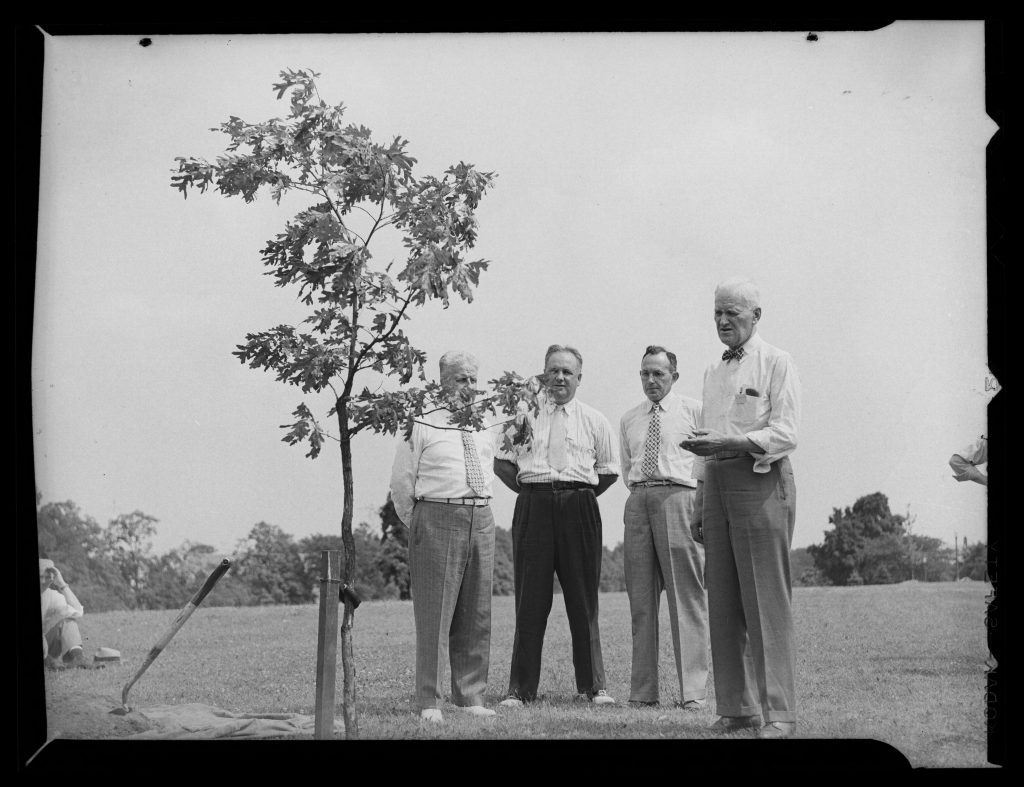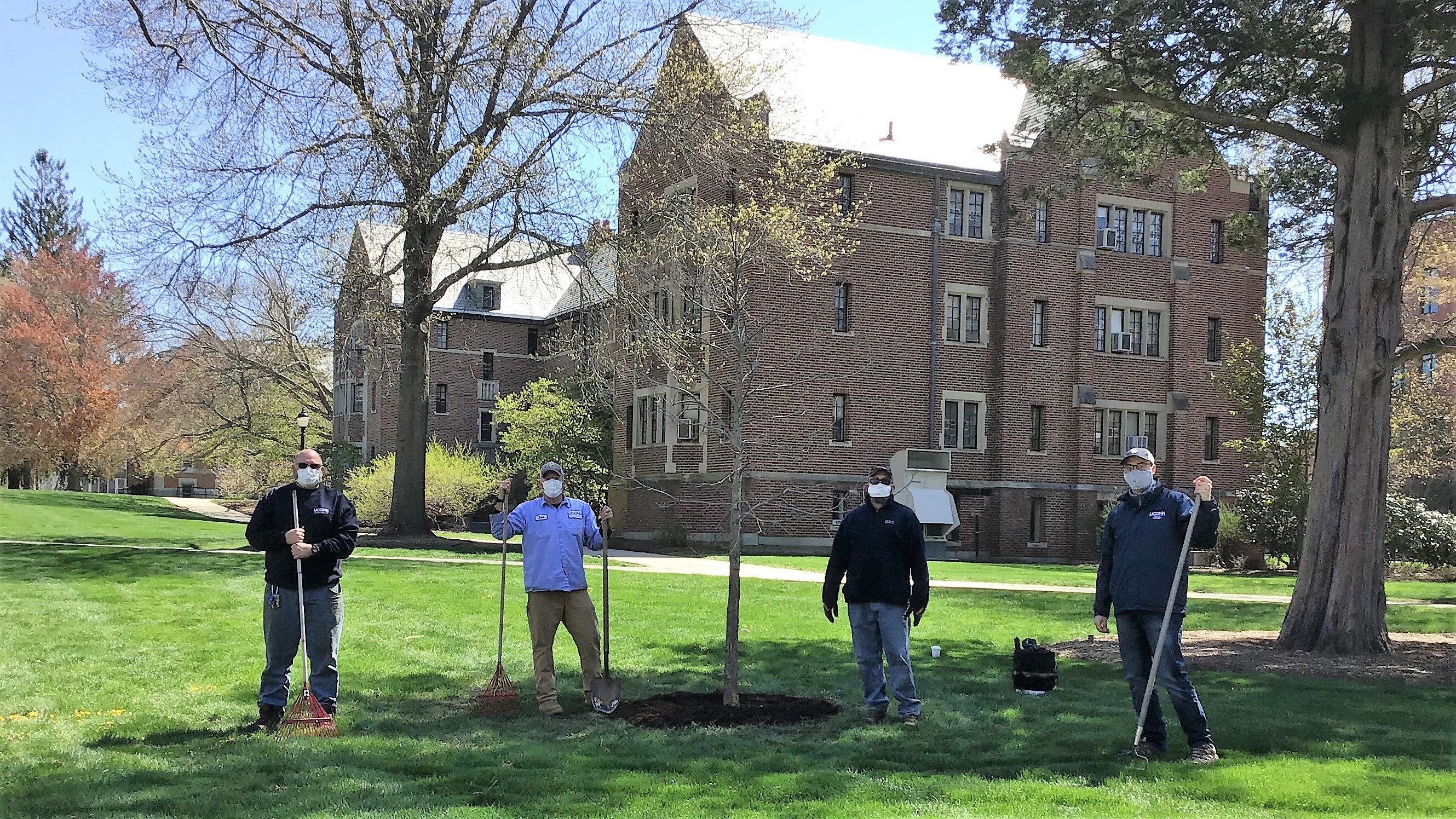Although members of the Class of 2020 faced an abrupt end to their time on UConn’s campuses with the onset of the COVID-19 pandemic, they’ve put down their roots in a significant and lasting way.
The official class tree, an overcup oak (Quercus lyrata), was planted a few days before Commencement in a sunny spot in the UConn Storrs heritage district, near the William H. Hall Building and Rowe Center for Undergraduate Education.
Many UConn classes have raised funds to buy and plant class trees over the decades, and it became a more formal annual initiative starting in 2018 through the UConn Arboretum Committee, with representatives of each graduating class.
“I was excited to help with this project because it feels like a way to leave UConn on a positive lasting note,” says newly minted graduate Sophie MacDonald ’20 (ENG) of Litchfield, a committee member and the lead student organizer on this year’s effort.
This year’s class tree planting was complicated by the COVID-19 pandemic and the need to transition almost all students and employees off campus. In fact, some Arboretum Committee members joke that the overcup oak could be nicknamed the “overcame oak,” given how many hurdles the Class of 2020 successfully crossed this spring to graduate during the pandemic.
On a day shortly before commencement, mild and clear weather presented the perfect opportunity for a handful of UConn facilities workers, all wearing protective masks, to complete the task and plant the tree in its permanent spot.
The overcup oak is described as a species known to adapt comfortably to most soil conditions, with dark green summer leaves that in the fall turn the brilliant yellow-brown shades that can be found on several other kinds of trees across UConn Storrs.
Its branches grow in a rounded way to create a crown-like appearance, and its acorns are particularly popular with squirrels and other small wildlife creatures. It’s also strongly resistant to pests and flooding, making it a hardy addition to most landscapes.
UConn’s tree population has a storied history, with the Storrs campus recognized as a Tree Campus USA by the Arbor Day Foundation – the only school in Connecticut and one of just three in New England with that designation.
Graduating students have been planting a “class tree” off and on for more than 125 years, with descriptions existing in the 1880s, not long after the institution was established as the Storrs Agricultural College.
In 1893, a willow was planted as the class tree near Swan Lake (then called the Duck Pond), not far from the pole bringing the first telephone line to President Benjamin F. Koons’ office.
The Board of Trustees’ report for 1898 includes a photo and description of that year’s planting, in which each student shoveled some of the dirt before a separate “class ivy” was also planted and the attendees gave three cheers for the Class of 1898.

The modern class tree initiative is led by emeritus professors Greg Anderson, Distinguished Professor of Ecology and Evolutionary Biology, and Richard Brown, Distinguished Professor of History. Both are members of the Arboretum Committee, with Anderson serving as one of its co-chairs.
“There are actually class trees all over campus from the 1950s and 1960s that are now very mature,” Anderson said in 2018 when the initiative was formalized.
“We would like the current students to take ownership of this and have each class plant trees. It brings people back to campus after they graduate,” he said. “They can show their children and grandchildren that this is a tree their parent or grandparent planted.”
The UConn Arboretum Committee helps oversee the care of the campus trees and shrubs, and manages an interactive map and inventory of more than 4,600 individual trees. It also produces a brochure to direct people through a self-guided tour of nearly 40 special selections.
The dedicated annual class tree plantings, in addition to celebrating each year’s graduates, help achieve UConn’s goals for a succession plan to ensure there are many healthy trees on campus as older mature trees decline in health or become hazards.
MacDonald said Anderson’s enthusiasm for the annual class tree planting made it even more enjoyable for her and the other students involved, especially as they envisioned visiting the mature tree someday with their families to share its story and meaning.
“I didn’t get to see the actual tree planting this year, but I imagine once I’m able to actually return to campus and see it in the ground, I’ll feel what (Anderson) wants me to feel: some sense of legacy, and some sense of peace,” MacDonald says.
Like Anderson, MacDonald knows and appreciates the value of the various trees around UConn’s campus, having helped in the work to re-certifying UConn as a Tree Campus USA for the past few years as an intern in the University’s Office of Sustainability.
The future of the initiative is in good hands: Two of the most involved students in this year’s efforts, Mara Tu and Emma MacDonald – Sophie’s sister – are juniors, and will already have experience with the tree-planting tradition in the coming year when they are seniors.
The class tree project is managed as part of the Campus Beautification Fund at the UConn Foundation. To make a donation to the fund, visit this link.



